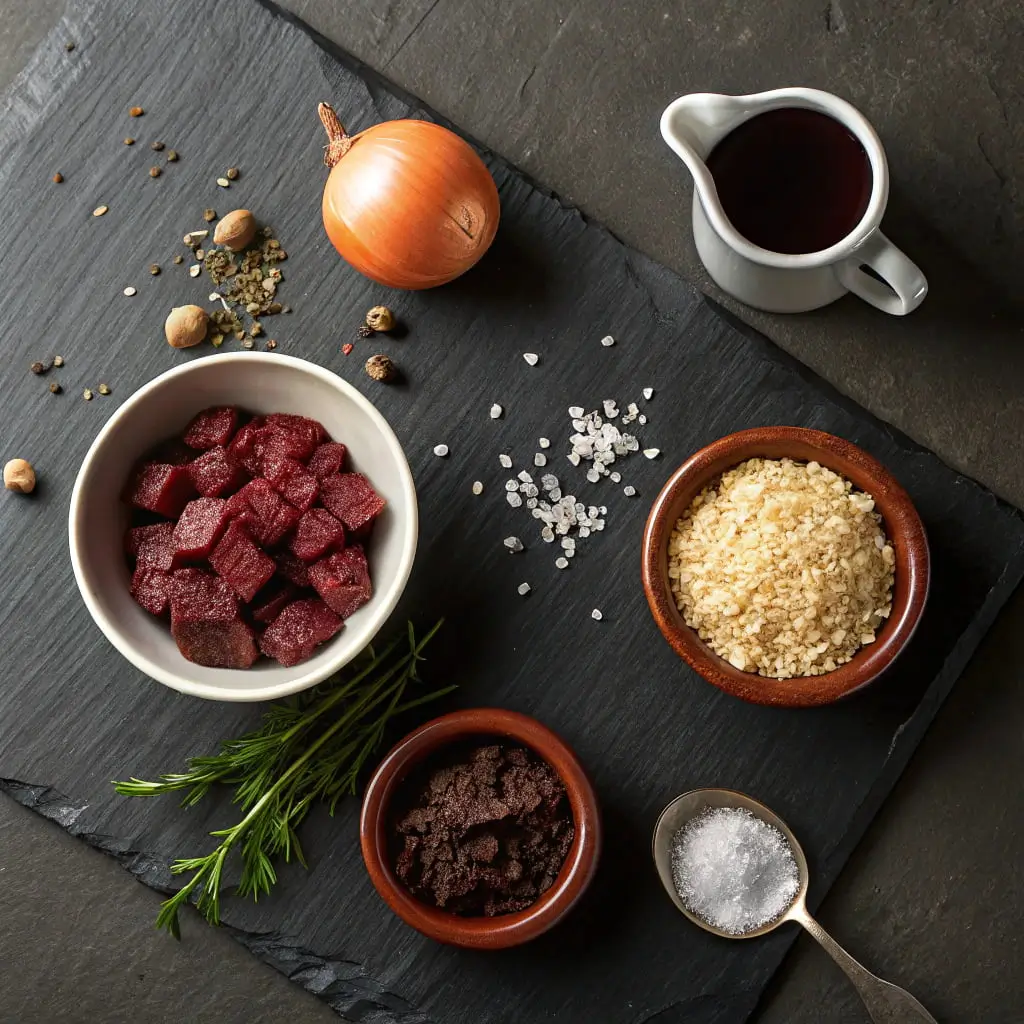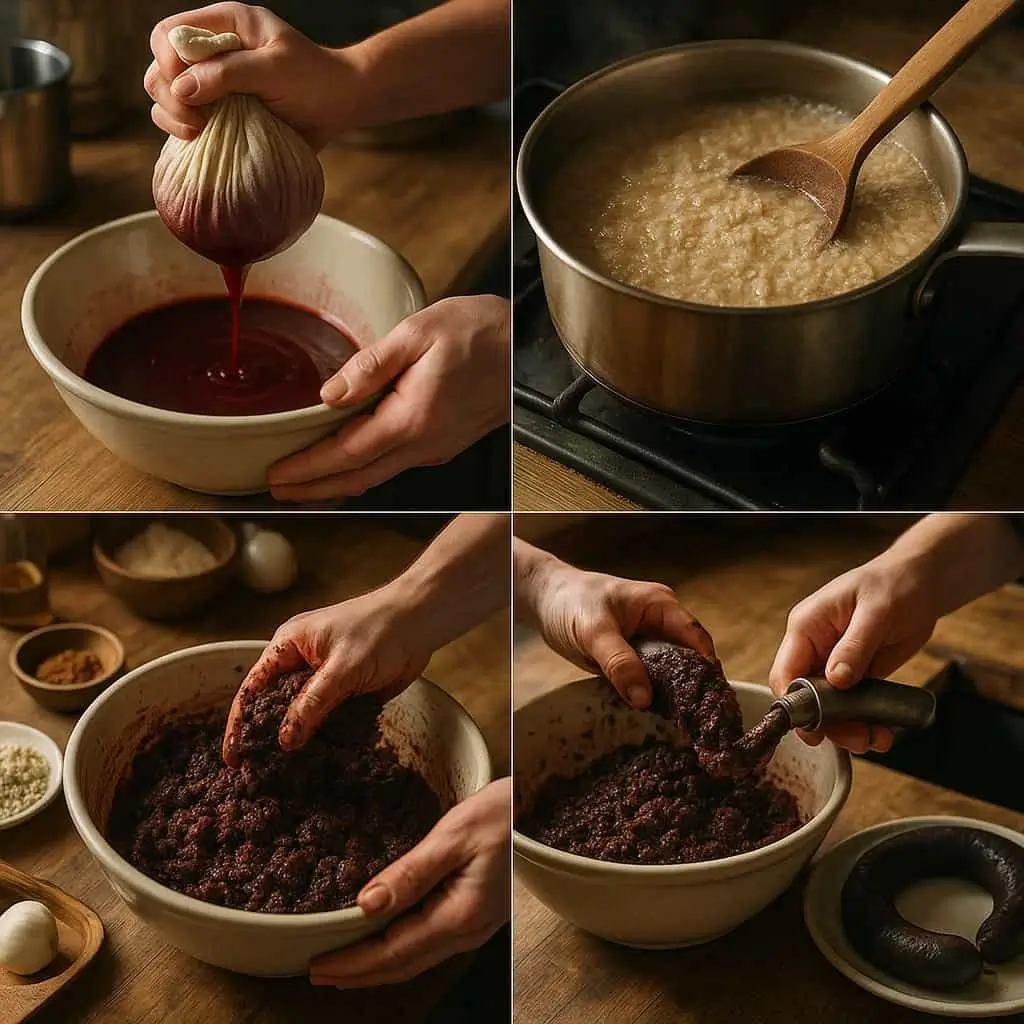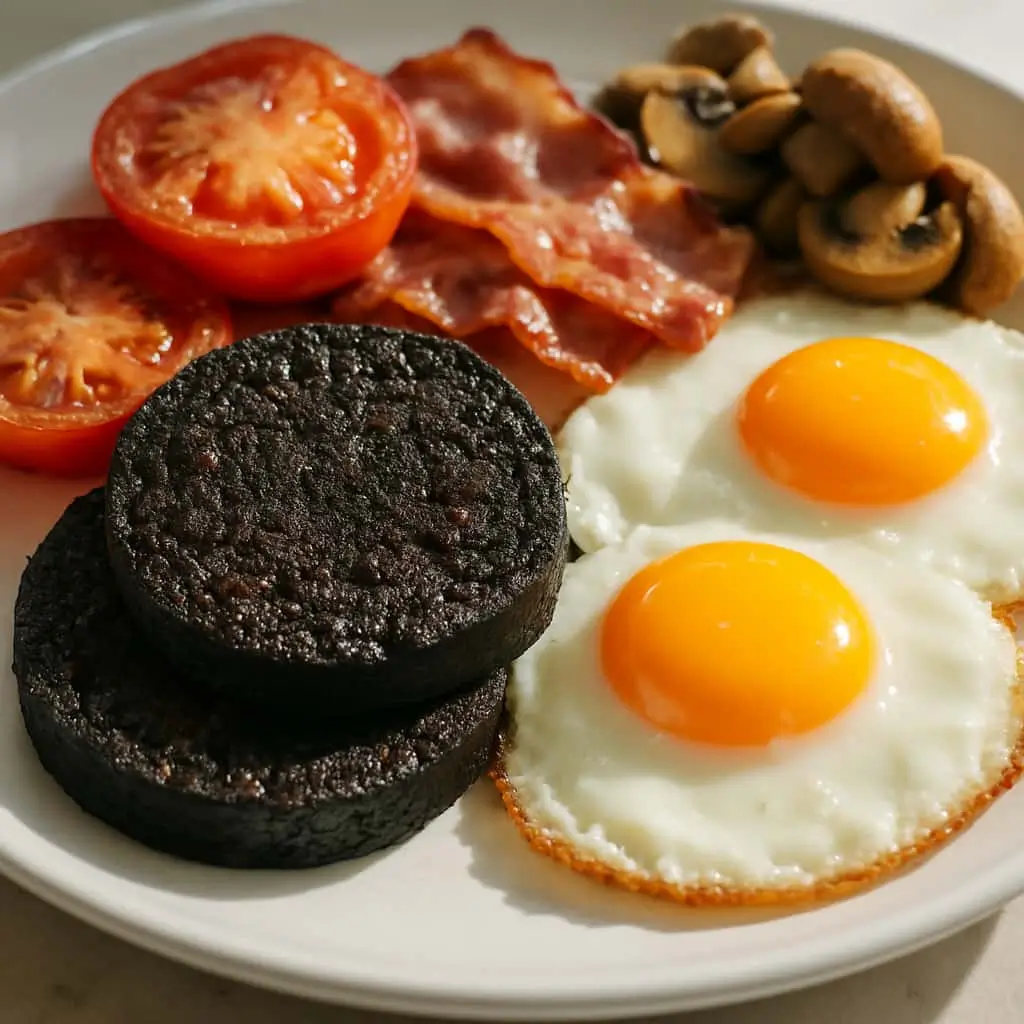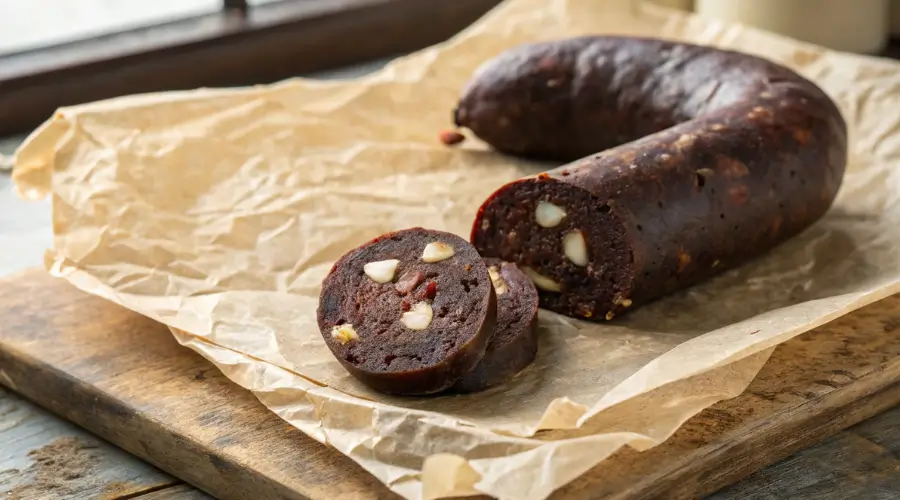Let’s be honest: the idea of making black pudding at home doesn’t scream “weekend project” for most people. It’s messy, it’s old-school, and yes, it involves blood. But here’s the kicker, once you get past the squeamish factor, you’re diving into one of the most soulful, storied dishes in British and Irish culinary history.
The homemade black pudding recipe we’re about to explore is not just a nostalgic throwback it’s a quiet rebellion against the overly sanitized, flavor-flattened versions sold in vacuum packs. Making your means you control everything: the seasoning, the texture, the casing. And the result? A rich, peppery, grain-flecked marvel that tastes like Sunday mornings in a country kitchen.
So if you’ve ever stared at a slice of black pudding on your fry-up plate and wondered how on earth it’s made or even thought, “Surely, I could do this better,” this guide is for you. We’ll break it down step by step, no judgment, no fluff, just honest food-making. And trust me, by the end, you’ll be more proud of that slice than any store-bought shortcut could ever offer.
Table of Contents
🧂 Ingredients for Homemade Black Pudding (Plus Substitutions)
Getting the right ingredients for homemade black pudding is half the battle, especially if you’re not exactly best mates with your local butcher. But don’t stress. Here’s everything you’ll need, with realistic workarounds if you can’t get your hands on the traditional stuff. If you’re looking for other savory dishes that utilize similar ingredients, our Cheesy Hamburger Potato Casserole: 5 Easy Steps To Make It is a comforting option to try.

Main Ingredients
- 500ml fresh pig’s blood
This is the non-negotiable. If you can’t find it fresh, look for dried blood powder as a substitute just rehydrate per package instructions. - 250g back fat (or beef suet)
Finely diced. Back fat gives a creamier finish, but suet works in a pinch. - 250g steel-cut oats (or pinhead oatmeal)
These give the pudding its distinct texture and soak up all the savory juices. - 1 large onion, finely chopped
- Salt (10g) and black pepper (5g)
Adjust based on how punchy you want the final taste. - Mixed spice (optional, 1 tsp)
Nutmeg, allspice, cloves this adds a hint of warmth. Some swear by it, some skip it. - Casing (natural hog casing or food-safe plastic sausage casing)
You’ll need enough to fit your mix, about 1.5 to 2 meters.
Ingredient Notes & Tips
- Where to buy pig’s blood: Your best bet is a local butcher or ethnic grocery (especially Polish, Spanish, or Filipino shops). Call ahead, it’s not always in stock.
- Back fat prep: Ask your butcher to dice it for you, or freeze and chop it at home when it’s slightly firm for easier handling.
- Oat options: Avoid rolled oats, they’re too soft and won’t hold up. Stick with steel-cut or pinhead for the right bite.
Can I make black pudding without blood?
Yes, but technically it becomes a “bloodless pudding” or a grain sausage. It might taste great with similar spices and texture, but it won’t deliver the same iron-rich flavor or authenticity. If you’re vegetarian or squeamish, a beetroot-lentil version is a creative alternative, though purists might scoff.
🔧 Equipment Needed to Make Black Pudding at Home (And Clever Alternatives)
Making black pudding might sound like a task reserved for professionals in apron-lined smokehouses but the truth is, with a few key tools, your kitchen is more than capable. Here’s what you’ll need to pull it off without a meltdown mid-batch. For those interested in baking with minimal equipment, our 4 Ingredient Banana Bread Recipe demonstrates how simple tools can yield delicious results
Essential Gear
- Large mixing bowl
You’ll be working with a decent volume, so go big or get messy. - Fine mesh strainer or cheesecloth
For removing clumps or impurities from the blood (if needed). - Sharp knife & chopping board
Essential for prepping fat and onion finely. - Large saucepan or stockpot
For parboiling the pudding. A heavy-bottomed pot gives better control. - Sausage stuffer or piping bag
Makes filling the casing easier. If you don’t have one? A funnel and steady hands work too albeit messier. - Butcher’s twine
To tie off the sausage ends. - Thermometer (optional, but useful)
Black pudding should hit an internal temp of 70–75°C. Guesswork is risky.
Nice-to-Have (But Not Essential)
- Kitchen scale
Precision counts when balancing blood, fat, and oats. - Clips or casing clamps
Makes sealing cleaner and more secure. - Vacuum sealer or freezer bags
For storing your pudding if you’re not eating it right away.
What if I don’t have a sausage stuffer?
No big deal. You can fashion a makeshift one using a plastic bottle (cut the top off) or a sturdy piping bag. The trick is to keep the casing well-lubricated (soaking helps) and don’t rush. It’s messy, but weirdly satisfying like edible arts and crafts.
🍳 How do you cook black pudding : Step-by-Step
This isn’t a quick 20-minute dinner job making black pudding is a half-day affair. But it’s also deeply rewarding, and once you do it once, the mystique fades. Here’s how to get from raw ingredients to glorious, earthy sausage. Remember that when making any type of sausage, following key food safety guidelines is crucial.

Step 1: Prep the Blood
- If using fresh blood: Strain through a fine mesh or cheesecloth to remove clots.
- If using dried blood: Mix with cold water as per instructions, and let sit 10–15 minutes to fully dissolve.
- Stir in a pinch of salt to help preserve while you prep the rest.
Step 2: Cook the Oats
- Add oats to a pot and pour in just enough water to cover them.
- Simmer gently for 10–15 minutes, until the oats are tender but still hold their shape.
- Drain any excess water and allow the oats to cool slightly.
⚠️ Tip: Don’t overcook. You want chewy, not porridge. The oats are what give the pudding its signature bounce.
Step 3: Combine Everything
- In a large mixing bowl, combine blood, cooked oats, chopped onion, diced fat, salt, pepper, and spices.
- Stir gently but thoroughly don’t whip air into it. You want a thick, cohesive mixture.
Step 4: Stuff the Casing
- Soak casing in warm water for 30 mins. Rinse inside and out.
- Thread onto sausage stuffer or funnel.
- Slowly fill with mixture, working air out as you go.
- Tie off ends with string, leaving a little give for expansion during cooking.
😅 Real talk: This part is messy. But if you get through it without swearing, you’re probably not doing it right.
The Cultural Significance of Black Pudding
Black pudding isn’t just food, it’s folklore in sausage form. It’s survived centuries, shifting diets, and more than a few culinary snobs who still side-eye the idea of eating blood. But if you grew up in the UK or Ireland, it’s more than a dish. It’s breakfast identity, with towns like Bury becoming synonymous with this revered food.
A Dish Older Than Your Great-Gran
Historians trace black pudding back to ancient times, we’re talking Roman-era blood sausages, possibly earlier. Why blood? Because nothing went to waste. In an era when people butchered their own animals, blood was just another ingredient to use with care and respect. And in places like Bury (Greater Manchester) and Clonakilty (Ireland), black pudding became a regional icon.
It’s been part of full English breakfasts, Scottish Lorne sausage stacks, Irish fry-ups — even posh gastropub menus. And in case you think it’s fading into the past, black pudding made a comeback as a superfood in the mid-2010s (thanks, protein content!).
A Symbol of Grit (and Gratitude)
To some, it’s just a meaty side. But to others, especially older generations, black pudding is survival food. It represents making do with what you had. It’s the kind of dish that carries memory in its flavor: of war rationing, working-class kitchens, and family breakfasts before hard days.
So when you make it at home, you’re not just stuffing a sausage. You’re taking part in a cultural ritual, one bite at a time.
What’s the difference between English, Irish, and Scottish black pudding?
It’s all about nuance.
- English versions (like Bury) lean heavily on oatmeal and pepper.
- Irish black pudding (Clonakilty-style) may include barley and a slightly looser texture.
- Scottish ones sometimes include beef suet and lean more savory.
All three are right just depends which kitchen raised you.
Step 5: Cook the Pudding
- Bring a large pot of water to a gentle simmer (not boiling boiling may split the casing).
- Add the pudding and poach gently for 30–40 minutes.
- Turn occasionally and check internal temp (should reach 70–75°C).
- Remove and let cool. Chill in the fridge overnight for the best texture.
🍽️ Serving Suggestions for Homemade Black Pudding
Alright — you’ve put in the work, braved the blood, and made something that smells like Sunday tradition. Now comes the fun part: eating it. Black pudding is incredibly versatile, from old-school breakfasts to modern gourmet twists, it plays well in almost any dish that needs a little earthy depth. Looking for a side dish to accompany your black pudding? Our Purple Cabbage Recipes You’ll Love provide vibrant and nutritious options

Classic Breakfast Combo
- The Full English or Irish Fry-Up:
Fry thick slices of your pudding until the edges are crisp and the center is still rich and tender. Serve with eggs (any style), bacon, grilled tomatoes, mushrooms, beans, and toast or soda bread. - Scottish-style breakfast:
Add it to a breakfast roll with tattie scones and Lorne sausage. Yes, it’s heavy and yes, it’s worth every bite.
Beyond Breakfast: Creative Uses
- Black pudding and scallops
A gastropub favorite. The creamy, slightly sweet scallop meets the iron-rich, crumbly pudding in a contrast that shouldn’t work but does. - Black pudding hash
Dice and fry with potatoes, onions, and peppers. Top with a poached egg for a brunch dish that makes avo toast look shy. - Pasta with attitude
Crumble black pudding into a creamy pasta sauce with garlic and sage. It’s like carbonara’s rebellious cousin. - Stuffing mix
Mix with breadcrumbs, herbs, and apple for a rich, punchy roast bird stuffing.
Can I eat black pudding cold?
Technically, yes it’s fully cooked once poached. But let’s be honest: it’s far better warm. Sliced and lightly fried, you unlock layers of flavor and texture that cold pudding just doesn’t offer.
Can I fry it right away?
Technically, yes but it’ll be soft and hard to slice. Chilling overnight firms it up beautifully. The next day, slice and fry in butter or oil until crisp at the edges and tender inside. That’s when the magic happens.
🛠️ Variations and Tips for Getting Your Black Pudding Just Right (Rewrite)
Here’s the thing once you’ve made black pudding once, you realize how much wiggle room there actually is. It’s not like baking, where precision is the law. Black pudding is more… negotiable. And that’s where the fun begins.
Tweak the Recipe, Own the Flavor
- More spice, less tradition: Don’t be afraid to go bold. A dash of smoked paprika, a little garlic, even chili flakes if you’re feeling cheeky they all transform the base flavor. Some purists may scoff, but hey, it’s your pudding.
- Fruity lift: Ever tried adding grated apple and a touch of thyme? Sounds weird, tastes wonderful. It balances the richness with a bit of brightness. Unexpected, but welcome.
- Beer-blooded: A splash of stout (think Guinness) can give the pudding a slightly bitter edge the kind of complexity you’d normally associate with slow-cooked stew or dark sauces.
- Grain swap: No steel-cut oats? Sub in pearl barley or even rice. Texture will shift, but it’s not a dealbreaker. In fact, it might be your new favorite version.
Tips You’ll Wish You Knew Before Batch
- Fridge is your friend: After poaching, let the pudding chill overnight. Warm black pudding is lovely, but trying to slice it warm? It’s a crumbling nightmare.
- Don’t max out the casing: Think of it like packing a suitcase. Leave space. The pudding expands a bit in the water too tight and you’ll end up with a burst sausage and regrets.
- Write it down: Seriously. If you tweak the spices or swap ingredients, scribble it somewhere. Otherwise, when you hit gold, you won’t remember how you got there.
- Slice before freezing: Future-you will thank present-you. There’s nothing worse than having to defrost the whole roll just for one fry-up.
- Texture troubleshooting: Crumbly? Cut back the oats a bit. Too soft? More oats or a longer chill before cooking. Every kitchen, and every batch, plays by its own rules.
How long does it keep?
In the fridge: 5 to 7 days, sealed tight.
In the freezer: Up to 3 months.
Sliced and frozen in portions? That’s the black pudding version of winning at meal prep.
🧾 Wrapping It Up: Why Homemade Black Pudding Is Worth Every Stir
So here we are blood, fat, oats, and all. If you’ve made it to the end of this recipe (or better yet, made your own pudding), you’re part of a small but passionate crew keeping one of the oldest food traditions alive.
Let’s not romanticize it too much making black pudding isn’t for everyone. It’s hands-on, a little gritty, and more than a little messy. But it’s also real. It connects you to something older than trends or TikTok food hacks. It’s a dish born out of necessity, shaped by time, and now, thanks to you, made with intention.
Maybe your first batch won’t be perfect. That’s okay. Actually, that’s better than okay it’s how the learning sticks. Maybe the casing split, or you went a bit heavy on the pepper. But next time, you’ll adjust. And before long, you’ll have a version that’s yours in every bite.
So, whether you’re making it to honor a tradition, impress your mates, or just to see if you can, know this: black pudding is a dish that gives back. One slice at a time.
🙋♂️FAQ
How is blood pudding made?
It’s a bit old-world, to be honest. You start with pig’s blood not the most common pantry item then mix it with steel-cut oats, bits of fat (usually from the back), onions, salt, pepper, maybe some warming spices. That’s the raw part. The real work? Getting it into sausage casings and poaching it slowly so it sets. It’s kind of like making a sausage, but one that feels more ritual than recipe.
Why is blood pudding illegal?
Good question and kind of a weird one. It’s not the pudding that’s illegal, it’s the blood. Or rather, how blood is handled. In countries like the U.S, there are strict rules about collecting and processing blood for food, mostly around hygiene and safety. So it’s not banned outright, but you probably won’t find it in your local supermarket. Still, if you’re making it at home and sourcing safely, you’re likely in the clear, legally and ethically.
Is eating blood pudding healthy?
Well, yes and no. It’s got a lot going for it protein, iron (the kind your body absorbs really well), and zero pretension. But it’s also high in fat and sodium, and let’s not pretend it’s a health food. That said, in small amounts, it can absolutely be part of a balanced diet. Especially if you’re someone who needs more iron, you might find it does more good than you’d expect.
Is blood pudding tasty?
Strangely… yes. It’s rich, savory, slightly mineral, with a texture that walks this line between soft and toothsome. When it’s fried just right, it crisps at the edges and tastes more like charcuterie than anything scary. But here’s the thing: the idea of blood puts people off before they even try it. If you can get past that, even just once, you might find it’s not just tasty, but kind of addictive. To balance savory flavors with a touch of sweetness, our Cinnamon Roll French Toast Casserole: A Sweet Treat offers a delightful contrast.

